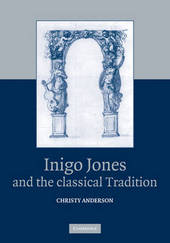
|
Inigo Jones and the Classical Tradition
Paperback / softback
Main Details
| Title |
Inigo Jones and the Classical Tradition
|
| Authors and Contributors |
By (author) Christy Anderson
|
| Physical Properties |
| Format:Paperback / softback | | Pages:294 | | Dimensions(mm): Height 254,Width 178 |
|
| Category/Genre | Individual architects and architectural firms |
|---|
| ISBN/Barcode |
9780521181310
|
| Classifications | Dewey:720.92 |
|---|
| Audience | | Professional & Vocational | |
|---|
| Illustrations |
Worked examples or Exercises
|
|
Publishing Details |
| Publisher |
Cambridge University Press
|
| Imprint |
Cambridge University Press
|
| Publication Date |
25 November 2010 |
| Publication Country |
United Kingdom
|
Description
Inigo Jones worked as hard on the creation of his architectural persona as he did on the design of the buildings for the early Stuart court. Through his study of continental architectural and art theory, humanist education, and courtly behavior, Jones redefined the intellectual status of architecture in England and forged a new role for the architect in public life. Since his death, he has been variously described as the first educated architect, the first classicist, the first Renaissance architect in Britain, and the savior of British building from the long winter of the Elizabethan style. This reputation has overlooked the many ways that Jones drew on English customs in order to shape classical architecture for a domestic audience. This 2006 book explores the creation of Jones as professional architect and the development of classical architecture in England through a study of his reading, writing, and architectural practice.
ReviewsReview of the hardback: 'Anderson strikes the right note in claiming that Jones created the Banqueting House as a personal reflection of James I's political rule, and considered that architecture was another, more permanent, form of court costume.' Literary Review Review of the hardback: 'Anderson's fascinating approach ... does an excellent job seeing him in the intellectual context of his day and demonstrating that he was an architect-scholar. ... There is a huge amount of interest in this book, aimed at the specialist reader.' Architectural Review
|